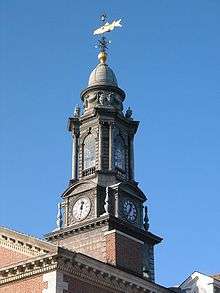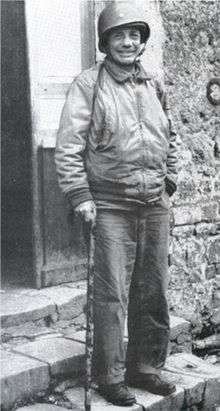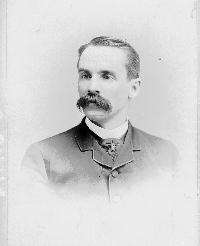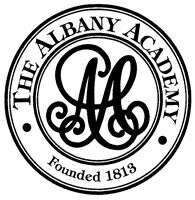The Albany Academy
| The Albany Academy | |
|---|---|
|
Honor Integritas Officium Honor, Integrity, Service | |
| Address | |
|
135 Academy Road Albany, New York 12208 USA | |
| Information | |
| Type | Private, College-prep, Day |
| Established | 1813 |
| Sister school | Albany Academy for Girls |
| CEEB code | 330035 |
| Head of school | Douglas M. North |
| Faculty | 50+ teachers |
| Grades | P–12 |
| Gender | Boys |
| Enrollment | 376 students |
| Average class size | 16 students |
| Student to teacher ratio | 9:1 |
| Campus size | 25 acres (100,000 m2) |
| Campus type | Suburban |
| Color(s) |
Red and Black |
| Athletics | 13 interscholastic sports teams |
| Athletics conference | Colonial Council; NEPSAC |
| Mascot | Cadets |
| Tuition | $12,950-$22,000 |
| Affiliation |
The Albany Academies NYSAIS |
| Website |
www |
The Albany Academy is an independent college preparatory day school for boys in Albany, New York, USA, enrolling students from Preschool (age 3) to Grade 12. It was established in 1813 by a charter signed by Mayor Philip Schuyler Van Rensselaer and the city council of Albany. In July 2007, the administrative teams of The Albany Academy and Albany Academy for Girls merged into The Albany Academies. Both schools retain much of their pre-merger tradition and character and each continues to give diplomas under its own name. Tuition ranges from $12,950 for Preschool, up to $22,000 for grade 12.
History
The Albany Academy is the oldest boys day school in the New York Capital Region, chartered in March 1813 to educate the sons of Albany's political elite and rapidly growing merchant class. In the Census three years prior, Albany was the tenth-largest city in the United States, and would remain so through the 1850s due to the prominence of the Erie Canal.

Classes began within months after the charter was granted, offering a college preparatory track (including intensive study of Ancient Greek, and Latin) and an arithmetic-based track to prepare young men for Albany's role as a center of commerce. Two years later, in 1815, a purpose-built building was completed in present-day Academy Park, adjacent to the New York State Capitol. The Federal-style building, now known as the Old Academy and headquarters of the City School District of Albany, was designed by renowned Albany architect Philip Hooker. The building is listed on the National Register of Historic Places for its architectural significance and role as home to scientist Joseph Henry's laboratory.[1]
In 1870, in response to a lack of military preparation institutions in the north during the American Civil War, the Albany Academy adopted the Battalion Leadership Program, instructing the "cadets" in military procedure and the art of leadership. In 2005 the school ended compulsory involvement in the program in favor of a House-based leadership program commonly found in English preparatory schools. The four houses, named for prominent historical Academy figures (Beck, Gates, Henry, and Olcott), compete against one another in the fields of academics, athletics, community service, and extracurricular involvement for honor and special privileges awarded to the leading house.

In 1931, the school moved from its original downtown building in present-day Academy Park to its current location on the corner of Hackett Boulevard and Academy Road, in the University Heights section of Albany. Designed by Marcus T. Reynolds in the neo-Georgian style, the building incorporates many elements of the Old Academy building, namely the main entryway and cupola. The school stands approximately two miles from the city center, allowing students access to the resources of the State University of New York at Albany, Russell Sage College, Rensselaer Polytechnic Institute, the state capitol, and the state museum and library. The red-brick Academy building's marble cornerstone was laid by the then Governor and future President Franklin D. Roosevelt. All grades enrolled in The Albany Academy are housed under the same roof, a point of pride for the Academy Community.
In 2005, The Albany Academy ended its long standing Army JROTC program. This decision came due to declining enrollment among other factors. Certain military aspects are still available to students, but are all "electives."
The Board of Trustees announced that The Albany Academy and Albany Academy for Girls would merge into The Albany Academies in July 2007. Single-gender education will continue under the present form in Lower and Middle Schools, while Upper School students may continue to cross-register for coed classes and certain extracurricular activities.
On July 1, 2009, the Board of Trustees announced the appointment of Douglas M. North AA'58, President of Alaska Pacific University, to the position of Head of School of The Albany Academies, effective July 2010.[2]
Facilities

The main Academic building houses 40 classrooms, two libraries, Mac and Windows computer labs, the cafeteria (called the Buttery), the school book store, the auditorium (known as Caird Chapel), the Wellness Center, the Black Box Theater, a darkroom, the Joseph Henry Science Wing, student and faculty lounges, board rooms, art and music studios, the school's archives, and various administrative offices. The school's athletic facilities include 11 team locker-rooms, 1 soccer/lacrosse field, 1 baseball diamonds, 1 football field, the 400-meter Robison Track, the Robison Hockey Arena (formerly home to the Albany Cougars, a special needs hockey team who now play at the Albany County Hockey Facility), 6 outdoor tennis courts, the 6-lane, 25-yard (23 m) Standish Pool, the Rea Fitness Center, 2 indoor gymnasiums, 2 squash courts, conference rooms, long- and high-jump pits, a discus court, and a shot-put court. Other on-campus facilities include Leonard House, the Head of School's residence.
Student body
Drawn predominately from a six-county area and from within a radius of 65 miles (105 km), the student body is ethnically, religiously, and economically diverse. The total 2005–06 school population is 340 boys, including 82 in the Lower School, 71 in the Middle School, and 187 in the Upper School. There is a total of six countries represented in the school. Students are encouraged to actively participate in all aspects of school life; they are expected to conduct themselves responsibly and treat each other and their teachers with respect. Students are responsible for upholding school rules. The Albany Academy adheres to a school-wide honor code. Student Council members, especially seniors, occupy important leadership positions at Albany Academy. Its Leadership Development Program prepares students to hold leadership positions at school and beyond by providing formal classes on leadership, advising/student mentoring, community service, and involvement in co-curricular programs—all within the structure of a British-modeled House System.
Mission statement
The Albany Academies—Albany Academy for Girls & The Albany Academy—are Preschool-Grade 12 independent college-preparatory single-gender schools committed to developing the potential of the whole individual by building a community that fosters scholarship, leadership, character, service and integrity. The schools' core values include responsibility, self-discipline, compassion, ingenuity, respect, service, integrity and perseverance.
Accreditation and memberships
The Albany Academies are accredited by the New York State Association of Independent Schools and recognized by the Regents of the State of New York.
The Albany Academies are a member of the following associations: the College Board, the Cum Laude Society, the National Association of Independent Schools, the Educational Records Bureau, the Capital Region Independent Schools Association, the Association of Boys' Schools, the Secondary Schools Admission Test Board, and the New England Prep School Athletic Association.
Alumni
Noted alumni include nine U.S. Congressmen, five Professional Athletes, three College Presidents, two Poets Laureate, one U.S. Supreme Court Justice, and one Medal of Honor recipient:
Government, law, business, and public policy

- T. Garry Buckley, 72nd Lieutenant Governor of Vermont.
- John W. Causey, United States Representative from Delaware
- Norton Chase, New York State Assemblyman and New York State Senator
- E. Harold Cluett, U.S. Representative from New York
- Andrew J. Colvin, District Attorney of Albany County and New York State Senator
- Edwin Corning, businessman, Lieutenant Governor of New York, father of Erastus Corning 2nd.
- Erastus Corning II, Mayor of Albany from 1942 to 1983; held the record for longest serving Mayor
- Parker Corning, U.S. Representative from New York
- Frederick A. Conkling, U.S. Representative from New York
- Learned Hand, Justice of the United States Court of Appeals for the Second Circuit, regarded as the most influential American Jurist never to sit on the Supreme Court of the United States
- Francis Hendricks, Mayor of Syracuse and President of the State Bank of Syracuse.
- Abraham Lansing, lawyer, New York State Treasurer, and New York State Senator
- James Campbell Matthews, attorney and judge, New York's first African-American law school graduate
- Roger McNamee, venture capital and private equity investor, founder of Elevation Partners and Silver Lake Partners
- Peter P. Murphy, physician and politician
- Stephen P. Nash, lawyer, president of the New York City Bar Association
- Frederic P. Olcott, banker, stock broker, and New York State Comptroller
- Rufus Wheeler Peckham, Associate Justice of the Supreme Court of the United States on the Supreme Court of the United States (1895–1909)
 Rufus Wheeler Peckham, Class of 1855
Rufus Wheeler Peckham, Class of 1855 - Wheeler Hazard Peckham, lawyer, U.S. Supreme Court nominee
- John Van S. L. Pruyn, U.S. Representative from New York
- William Gorham Rice, New York state government official, U.S. Civil Service Commissioner
- Henry M. Sage, New York State Assemblyman and New York State Senator
- Charles Emory Smith, U.S. Minister to Russia (1890–1892), U.S. Postmaster General (1898–1902)
- Phillip Steck, Democratic member of the New York State Assembly
- Peter G. Ten Eyck, U.S. Representative from New York
- John Boyd Thacher II, Mayor of Albany from 1926 to 1941
- Ralph W. Thomas, New York State Senator
- Charles Tracey, U.S. Representative from New York
- Chauncey Vibbard, organizer of the New York Central Railroad and U.S. Representative from New York
- Henry Waldron, U.S. Representative from Michigan
- Charles W. van Rensselaer first officer and paymaster aboard the SS Central America when it was lost during a hurricane in September 1857
Medicine and academia
- John Seiler Brubacher, author, educational philosopher, Yale University professor
- Andrew Sloan Draper, jurist, author, and President of the University of Illinois
- William Durden, President of Dickinson College
- Henry Hun, Physician and Professor of Nervous Diseases at the Albany Medical College
- Jesse Montgomery Mosher, Physician credited with establishing the first psychiatric ward within the organization of a general hospital
- Douglas M. North, President of Alaska Pacific University and Prescott College, and Head of School of The Albany Academies
- Martin Seligman, psychologist at the University of Pennsylvania known for his work on learned helplessness and positive psychology
- Horace Silliman, businessman, philanthropist, namesake of Silliman University
- Howard Townsend, physician and medical professor
- William Bell Wait, teacher in the New York Institute for the Education of the Blind who invented New York Point, a writing for the blind before Braille
- Julian Gibbs, President of Amherst College
Literature and journalism
.jpg)
- Gordon Ackerman, journalist, writer, and photographer
- Stephen Vincent Benét, poet laureate, two-time winner of the Pulitzer Prize (1929, 1944)
- William Rose Benét, poet laureate, winner of the Pulitzer Prize (1942)
- Herman Melville, author of Moby-Dick
- Andy Rooney, author, journalist, and commentator for 60 Minutes
- Christopher Cuomo, Emmy Award-winning television journalist for CNN
Science and technology
- John Bogart, civil engineer and New York State Engineer and Surveyor
- Verplanck Colvin, lawyer, author, illustrator, and topographical engineer involved in the creation of the Adirondack Park
- Benjamin Boss, astronomer and editor of the Astronomical Journal
- Joseph Henry, natural philosopher, telegraphy pioneer, first Curator of the Smithsonian Institution
- Henry Ramsay, civil engineer and New York State Engineer and Surveyor
Arts, sports, and entertainment
- Raymond Castellani, actor, Los Angeles philanthropist
- James Carpinello, American film, television, and Broadway actor
- Marc Cavosie, professional ice hockey player
- Craig Darby, retired NHL ice hockey player
- Joseph R. Grismer, Albany-born actor, playwright and theatrical producer
- Stephen Hannock, landscape painter
- Craig Hatkoff, co-founder of the Tribeca Film Festival and Tribeca Film Institute
- Ashton Holmes, film and television actor best known for the role of Jack Stall in A History of Violence
- David Holloway, American football linebacker formerly of the Arizona Cardinals
- Michael Patrick Jann, director of the film Drop Dead Gorgeous and actor on MTV's The State
- Kevin Leveille, professional lacrosse player for the Chicago Machine and the Chicago Shamrox
- Mike Leveille, lacrosse player, 2008 Tewaaraton Trophy winner, member of the Chicago Machine
- Dion Lewis, running back for the New England Patriots in the National Football League
- Marcus T. Reynolds, architect and author
- Merrick Thomson, professional lacrosse player for the Toronto Nationals and the Philadelphia Wings
- Steve Wulf, executive editor at ESPN The Magazine
- James Carpinello, Broadway actor (Saturday Night Fever, Rock of Ages) TV actor(Mob Doctor,Gotham)film actor(The Punisher,The Great Raid.Gangster Squad, Let's Kill Ward's Wife)
Military

- Jacob Downing, Union Army officer during the American Civil War, early developer of the city of Denver.
- Theodore Roosevelt Jr., U.S. Army Brigadier General and Medal of Honor recipient
- Jeff Sharlet, Vietnam Veteran, leader of the GI resistance movement during the Vietnam War
- Charles Dwight Sigsbee, Admiral in the U.S. Navy, Captain of the USS Maine when it exploded, igniting the Spanish–American War
- Frederick Townsend, Union officer in the American Civil War, Adjutant General of the State of New York
- Robert Townsend, Civil War-era U.S. Navy Captain commanding the ironclad USS Essex
- Egbert Ludoricus Viele, Brigadier General in the Union Army, military governor of Norfolk, Virginia; U.S. Representative from New York
Theology
- Angus Dun, 4th Bishop of the Episcopal Diocese of Washington in Washington, DC
- John Loughlin, 1st Bishop of Brooklyn, New York (1853–1891)
- Clarence A. Walworth, attorney, writer, Roman Catholic priest, and missionary
Faculty/administration
Noted former faculty and administration include inventors, politicians, and seven College Presidents, including four Presidents of Amherst College:

- George W. Atherton, President of the Pennsylvania State University
- Simeon Baldwin, Mayor of New Haven, Connecticut, U.S. Representative, Justice on the Superior Court of Connecticut
- Theodric Romeyn Beck, forensic medicine pioneer
- William Henry Campbell, President of Rutgers University
- John Chester, the second president of Rensselaer Polytechnic Institute
- George Hammell Cook, chemistry, geology professor, vice president of Rutgers University, director New Jersey Geological Survey
- Merrill Edwards Gates, President of Amherst College and Rutgers University
- Peter Gansevoort, member of the New York State Assembly and New York State Senate
- Julian Gibbs, President of Amherst College
- Joseph Henry, natural philosopher, telegraphy pioneer, first Curator of the Smithsonian Institution
- Albert Hull, physicist, inventor of the magnetron and dynatron
- Alexander Meiklejohn, President of Amherst College, Dean of Brown University, winner of the Presidential Medal of Freedom
- David Murray, American educator and government adviser in Meiji period Japan, Professor, Rutgers University
- George Olds, President of Amherst College
- Charles Emory Smith, U.S. Minister to Russia (1890–1892), U.S. Postmaster General (1898–1902)
- Frederick Townsend, Union officer in the American Civil War, Adjutant General of the State of New York (1857–1861, 1880)
See also
References
External links
| Wikimedia Commons has media related to The Albany Academy. |
- NRHP nomination for the original Albany Academy building: Waite, Diana S. (January 1970). "National Register of Historic Places Inventory/Nomination: Joseph Henry Memorial (Albany Academy)". New York State Office of Parks, Recreation and Historic Preservation. Retrieved 2011-07-31. See also: Accompanying one exterior photo from 1962
- The Albany Academies
- Petersons.com School Profile


